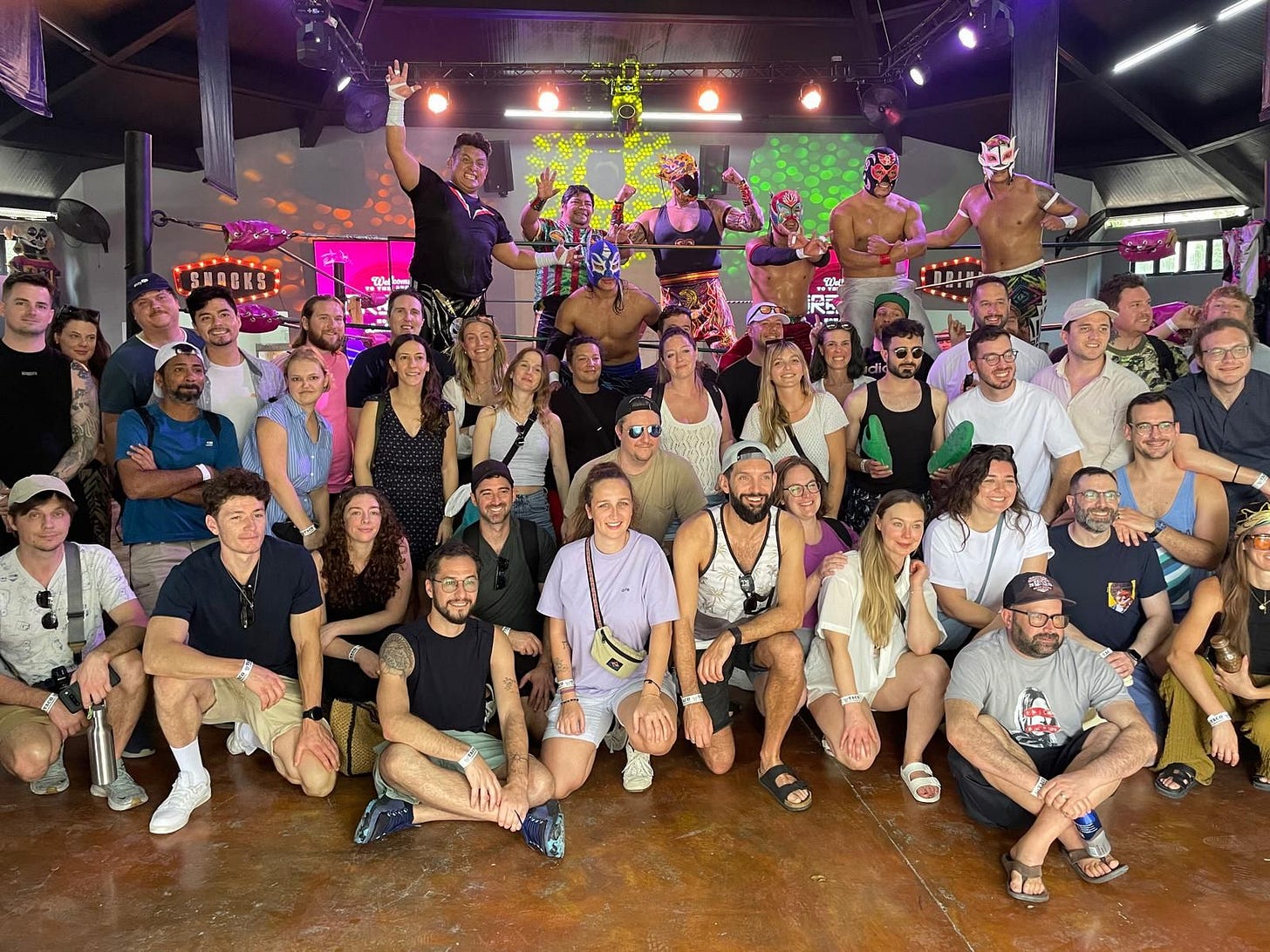How an e-sports booking headache sparked a +$1 billion revolution in travel monetization
Welcome to the 4th sponsored deep dive on Travel Tech Essentialist. I publish six of these per year, each one zooming in on a standout company that’s shaping the future of travel. They’re free for all subscribers and meant to go deeper than the usual headlines, with practical insight into strategy, execution, and what’s actually working. If you’re curious how I pick these companies, here’s the thinking behind it.
Today, we focus on Stay22, a Canadian startup quietly reshaping how creators monetize travel content. In doing so, they’re laying the groundwork for what might become a core layer of travel’s emerging creator economy.
Let’s dive in.
The 400% effect
When Lukáš Konečný looked at his travel blog’s revenue for October 2024, the numbers told a story that would have seemed impossible a year earlier. His monthly affiliate income from accommodation bookings had surged from €400 to €3,200; a 400% increase that came almost entirely from one change: implementing Stay22’s tools.
This wasn’t a fluke. The next month brought similar numbers. Looking at his data, the transformation was clear: from January to June 2023, he’d made $2,801 from 299 bookings. In the same period in 2024, after switching to Stay22, he earned $13,319 from 731 bookings – 144% more bookings, generating 375% more revenue. Something fundamental had changed in the economics of travel content.
Lukáš isn’t alone. Across the travel creator ecosystem, content producers are seeing their revenue multiply by 3x – 10x after implementing Stay22’s tools. Olly Gaspar from We Seek Travel funded his wedding with his Stay22 earnings. Climate-Data.org discovered they could make more money from Stay22 than from their advertising slots. The pattern was becoming clear: Stay22 wasn’t just incrementally improving travel content monetization. It was transforming it.
But to understand how Stay22 is transforming the economics of travel content, we need to rewind to a frustrated developer at an e-sports event in Germany.
From frustration to innovation
Stay22’s origin story begins with a familiar scene: CTO and co-founder Hamed Al-Khabbaz juggling browser tabs, trying to find accommodation near an e-sports event. The fragmented booking experience was frustrating and he felt like there had to be a better way to see all available options on a map.
So he built one.
But what started as a simple map-based solution would evolve into something far more ambitious: a complete reimagining of how travel content drives booking revenue.
When Hamed partnered with CEO Andrew Lockhead, they saw potential beyond just solving the accommodation search problem. They envisioned building the infrastructure that would let any content creator or platform efficiently monetize travel intent.
The triple threat that created resilience
Like many great pivots, Stay22’s transformation into what it is today came through crisis, or rather, three successive crises that would have killed most companies.
First came COVID. In early 2020, Stay22’s revenue plummeted from $128,000 in January to just $9,000 in April, a staggering 90% drop as global travel essentially stopped. The company’s primary clients, event and ticketing platforms, effectively disappeared overnight.
Crisis creates clarity, though. While competitors rushed to layoffs and cost-cutting, Stay22 took a different approach. Instead of waiting for events to return, they identified a new opportunity: people weren’t traveling abroad, but they were traveling locally for activities. Stay22 quickly integrated into the activity-based travel ecosystem and positioned itself to capture the shift toward local Airbnb bookings; someone traveling for hiking would need accommodations with a kitchen, for example.
The strategy worked remarkably well. By September 2020, revenue had rebounded to $51,000; by March 2021, they had fully recovered to $128,000 monthly revenue. More importantly, they began exploring a new market segment: travel bloggers and content creators. This seemingly defensive move would prove transformational.
Just as they gained momentum, the second crisis hit: Airbnb abruptly shut down their affiliate program in March 2021, instantly eliminating 80% of Stay22’s booking inventory. Revenue dropped to $95,000 in April, a 26% decline during what should have been a seasonal upswing.
But COVID had taught them to be prepared. Stay22 had already established contingency plans and was in discussions with VRBO and Trivago. This forward-thinking approach meant that by May 2021, revenue had not just recovered but grown to $135,000. By October that same year, it had skyrocketed to $440,000 monthly.
The third blow came from Google in March 2024, with a core algorithm update (GCU) that slashed partner traffic by 15%. Between February and March, clicks across all Stay22 products dropped from 12.2 million to 10.4 million, particularly concerning since March should have shown seasonal improvement over February. This translated to a 20% revenue drop during what should have been a hyper-growth period.
Again, Stay22 responded with agility. After GCU slashed traffic, Stay22’s team shifted focus to non-search sources like branded and direct traffic. By securing partnerships with iconic French travel brands like Routard, Petit Futé, and Generation Voyage, Stay22 proved their ability to drive strong results for major publishers, opening a new audience segment. Coupled with product improvements, they recovered completely within just two months. By May, clicks had rebounded to 14 million, surpassing pre-update levels.
Rather than merely surviving these setbacks, Stay22 used each crisis to fuel innovation. The result was Let Me Allez (LMA), a product that would fundamentally change how travel content converts to revenue, developed specifically for the content creator market they had begun exploring just two weeks before the Airbnb crisis.
Building the creator’s money machine
Today, Stay22 offers three core products, each solving a distinct piece of the travel monetization challenge:
Maps: the foundation
The original product, an embeddable map showing accommodation options, remains perfect for events and ticketing platforms. When someone buys concert tickets, they see a map of nearby hotels. Simple, effective, useful.
But Stay22’s true innovation came in how they evolved beyond maps.
Allez Links: the bridge
Allez links are like traditional affiliate links on steroids. Instead of linking to a single provider, they aggregate inventory from multiple booking platforms. But the real magic is in the automation: variables like event times, dates, and locations can be coded once and templated across an entire site. When someone clicks one of these links, the information about the event is automatically inserted, and the link sends them to an accommodation that is relevant to them.
For platforms like Bandsintown, this means every event page automatically displays relevant accommodation options without manual updating. This link opens the image below:
Let Me Allez: The game-changer
Let Me Allez (LMA for short) is where Stay22’s vision fully comes together. It’s an AI-powered script that transforms any travel content into a booking opportunity in a way that feels natural, not forced.
The core innovation that comes with this script is Nova, Stay22’s AI engine that detects genuine travel intent. Rather than the traditional approach of saturating pages with booking links, Nova observes specific user behavior patterns and introduces relevant accommodation options only when someone demonstrates real interest in a destination.
Nova’s intelligence comes from sophisticated “smart beacons” that monitor multiple signals: location data, page view patterns, scrolling behavior, time spent on content, the distance between a user’s current location and the destination they’re exploring, and several proprietary factors that Stay22 considers their “secret sauce.” When these signals collectively reach certain thresholds, Nova activates.
In practice, this creates seamless experiences that feel almost prescient. A reader exploring several articles about Bali without clicking any accommodation links would, at just the right moment, receive a suggestion for relevant Bali accommodations in a new tab. The system recognizes the sustained interest and presents options when the user is most receptive.
This precise targeting explains the “400% effect” we opened with. LMA doesn’t simply increase the quantity of booking links – it fundamentally improves conversion quality by connecting travelers with the right offers at optimal moments in their discovery journey.
The technology is supported by several technical advantages:
-
Extended cookie windows (24 hours to 7 days, versus the industry-standard session-based tracking that expires when a user closes their browser)
-
Automatic link repair that ensures dead or outdated links never frustrate potential bookers
-
Intelligent redirection based on user demographics and behavior patterns
-
Dynamic offer timing that adapts to individual browsing rhythms
For content creators, this introduces a radically different approach to monetization – one that enhances rather than interrupts the user experience. Readers get genuinely helpful suggestions that feel like a natural extension of their content exploration, while creators generate significantly higher revenue without compromising content quality.
“Bloggers and travel media who’ve installed LMA tend to see a huge uptick in bookings, anywhere from 3x to 10x, and obviously this is reflected in their revenues” — Andrew Lockhead, Stay22 CEO

The numbers game
Stay22’s growth tells a compelling story about the opportunity in travel content monetization:
-
2020 GMV: $12 million
-
2021 GMV: $44 million
-
2022 GMV: $75 million
-
2023 GMV: $250 million
-
2024 GMV: $500 million
-
Q1 2025 GMV: $280 million
That’s 4000% growth from 2020 to 2024, with an accelerating trajectory.
This growth comes from a genuine network effect: as creators see success with Stay22, they share these results with others in their communities. The company has built this momentum with minimal marketing investment, instead relying on the natural word-of-mouth that happens when partners see their affiliate revenues multiply.
Beyond organic referrals, Stay22 maintains a targeted sales presence at industry events and methodically explores new market segments. Their expansion from individual bloggers to larger travel media companies, publishers, and even weather platforms shows their ability to find travel intent in places traditional booking engines have overlooked.
What stands out is Stay22’s approach to partnerships. With just 3,192 partners generating half a billion in GMV, they’ve emphasized quality relationships that deliver substantial volume. This focus allows them to provide personalized support to each partner while maintaining operational efficiency; a balance that creates both happy partners and sustainable economics.
Accidents and insights
Some of Stay22’s most interesting opportunities have come through serendipity. Take weather websites: what started as an experimental sales pitch has transformed into a major revenue stream.
When a Stay22 sales representative first proposed targeting weather platforms, it seemed tangential to their core business. Yet the logic was compelling: people routinely check weather forecasts before booking travel, creating a perfect moment to capture booking intent that was already present but never converted.
Climate-Data.org provides a perfect case study of this unexpected fit. The global weather platform was searching for ways to increase revenue without compromising user experience or complicating their technical setup. After disappointing results with traditional OTAs, they implemented Stay22’s LMA solution in June 2024.
The implementation took minutes rather than weeks, and the results were immediate: a 40% increase in average revenue per thousand impressions (RPM) while actually enhancing the user experience. Rather than cluttering pages with display ads that Google updates had made less effective, Stay22’s technology only activates when it detects genuine travel intent.
Alexander Merkel, Climate-Data’s founder, notes: “I tested different things, including ad positions, and then realized, okay, if I reduce the number of ads, I get more revenue with Stay22 than with these ads”
This experience taught Stay22 an important lesson about growth: sometimes your best opportunities come from listening to unusual customer requests rather than following a rigid roadmap. Through strategic partnerships with WeatherBug, Meteo Consult and others, weather platforms are now one of Stay22’s fastest-growing segments, demonstrating how travel intent exists in places traditional booking engines have overlooked. The company has built this insight into their expansion strategy, actively testing their technology in adjacent markets rather than staying confined to traditional travel verticals.
What could go wrong?
Stay22’s impressive trajectory isn’t without hurdles. As the company scales toward the enterprise market, several challenges require attention:
Scaling personal touch: Stay22’s high-touch support model becomes increasingly difficult to maintain as partner numbers grow. The company is addressing this by developing self-service tools and improved documentation while carefully stratifying partner support based on volume and needs.
Competitive response: Success inevitably attracts imitators. While Stay22 currently enjoys a first-mover advantage with their AI-driven approach, competitors with deeper pockets could emerge. Stay22’s defense lies in their data advantage; with over 2 billion pageloads processed in 2024 alone, their AI models have developed nuance that would take competitors significant time to replicate.
Platform risk: The recent Google Core Update highlighted Stay22’s vulnerability to algorithm changes. Similar risks extend to social media platforms, where algorithm changes could affect content discovery patterns. Stay22’s diversification into multiple traffic sources (direct partnerships, weather platforms, media companies) creates resilience, but search dependence remains a vulnerability they continue to address.
User experience balance: Finding the sweet spot between monetization and user experience requires constant refinement. In response to isolated complaints about popups, Stay22 has tuned their Nova technology to suggest bookings to only 3-5% of a website’s audience, specifically those showing the highest travel intent, and limits suggestions to approximately once every 40 days per user. This approach prioritizes long-term partner reputation over short-term conversion gains.
Stay22 is now focusing on breaking into the US publisher market. This is both a huge opportunity and a test of how well they can handle the challenges above. Large publishers can bring massive traffic, but they have strict technical requirements and high standards for user experience. Stay22 is spending considerable time meeting with these publishers to show how their tools can fit into existing revenue strategies without disrupting what already works.
As with their weather site discovery, Stay22’s approach to these challenges seems characterized by methodical experimentation rather than rigid planning, testing hypotheses in market segments where their technology might create unexpected value while continuously refining their core offering.
The future is creator
Stay22’s vision for the next 5-10 years is ambitious but focused: become the universal platform for travel monetization. What makes this vision compelling isn’t just its scope, but their systematic approach to achieving it.
Instead of building another travel booking platform, Stay22 is positioning itself as the infrastructure layer that connects content to commerce across any medium where travel intent exists. Text, video, VR, whatever comes next—Stay22 wants to be the bridge that turns that intent into revenue.
Their expansion into video, specifically YouTube, represents this vision in action. With travel vlogging exploding and YouTube becoming a primary trip-planning platform, the opportunity is substantial. True to their creator-centric approach, Stay22 has engaged 50+ YouTubers in their beta program to help shape the product rather than prescribing solutions. This methodical expansion into video content mirrors their successful approach with bloggers: let creators guide product development.
Their roadmap for the next 12 months reflects this focus, with clear phases for growth:
Phase 1: Laying the Foundation for Scalable Partner Growth
-
Autonomous Partner Onboarding that reduces friction for new creators
-
Enhanced Partner Data Accessibility for better decision-making
-
Actionable Insights that help partners optimize their content strategy
Phase 2: Expanding Monetization & Revenue Streams
-
Retail Merchant Monetization beyond just accommodations
-
YouTube Integration for video content monetization
Phase 3: Scaling & Optimizing Partner Tools
-
Simplified Widget Deployment for non-technical partners
-
Expanded widget catalog spanning travel and retail verticals
-
Intelligent Accommodation Supplier Optimization
At the heart of this strategy is Roam, Stay22’s AI-powered technology that fundamentally improves how affiliate links work. With over 2 billion data points training their models, Roam transforms generic affiliate links into intelligent connections by:
Destination Optimization: Reading page content to determine destinations and converting generic OTA homepage links into deep links. For example, a standard link to Booking.com’s homepage from a Bali article would automatically redirect to Booking.com’s Bali-specific page.
Landing Page Optimization: Analyzing visitor behavior to determine whether a user should land on a specific hotel page or a search results page with options. This seemingly small adjustment increases conversion rates by approximately 10%.
Supplier Optimization (coming soon): Identifying which booking platform a user prefers and redirecting them there. If a user typically books through Booking.com but clicks a link to Kayak, Roam will show the same accommodation on their preferred platform.
This approach is shaped by three key trends Stay22 sees emerging:
-
Travel planning is becoming more immersive and interactive. The days of scrolling through static hotel listings are numbered. Stay22 is preparing for a world where travel discovery happens through rich, interactive experiences.
-
AI-driven personalization will become the norm. Stay22’s early investments in AI for detecting and acting on travel intent position them well for this shift.
-
The product scope will expand beyond accommodation. Stay22 plans to incorporate more travel-related services through partnerships with industry players, making the platform a comprehensive monetization solution.
“We’re the experts at reaching the right audience at the right time with the right offer, while creators and publishers do what they do best …creating quality content.” — CEO Andrew Lockhead
This laser focus on solving the monetization problem, while letting creators focus on creation, reflects a deeper understanding of what’s changing in travel content. Traditional marketing channels are losing effectiveness as consumers increasingly trust creators over brands. By building the infrastructure that connects creator content directly to commerce, Stay22 is positioning itself at the center of this shift.
Recent partnerships with major platforms and media companies suggest this bet is paying off. As the creator economy continues to grow, Stay22’s position as the essential bridge between content and commerce could make it a crucial player in the future of travel distribution.
In an industry often distracted by blockchain, AI, and metaverse concepts, Stay22’s focus on the core problem of helping creators make money emphasizes the value of addressing real pain points, rather than getting caught up in the latest technological solutions.
Looking back at Lukáš Konečný’s 400% revenue increase that we opened with, the story reveals something much larger than one creator’s success. The transformation that turned €400 into €3,200 for a single blogger now scales across weather sites, major publishers, and soon, video platforms. The original promise of connecting travelers with accommodation at exactly the right moment in their discovery journey remains central, while the canvas continues to expand. Stay22 builds more than tools; they’re reconstructing the economics of travel content in a creator-centric world. The 400% effect has evolved beyond a single metric into an industry-wide shift in how travel intent converts to value.
This is the 4th sponsored deep dive on Travel Tech Essentialist. I write these pieces to highlight innovative companies shaping the future of travel, with full editorial independence. To ensure quality and exclusivity, I limit these deep dives to just 6 per year. If you’re a travel company interested in being featured in a future sponsored deep dive, please visit my deep dive philosophy page to understand my selection criteria and reach out through the contact link there.








